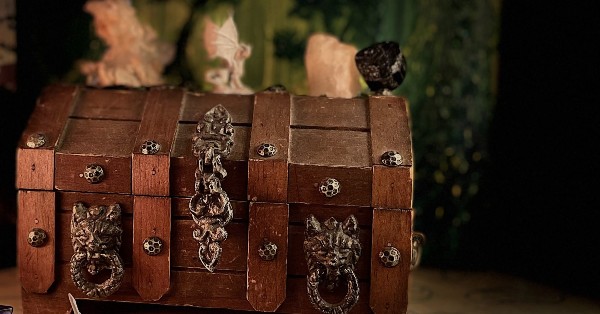You choose one object that you must touch throughout the casting of the spell. If it is a magic item or some other magic-imbued object, you learn its properties and how to use them, whether it requires attunement to use, and how many charges it has, if any. You learn whether any spells are affecting the item and what they are. If the item was created by a spell, you learn which spell created it.
If you instead touch a creature throughout the casting, you learn what spells, if any, are currently affecting it.
Casting Time: 1 minute
Range: Touch
Components: V, S, M (a pearl worth at least 100 gp and an owl feather)
Duration: Instantaneous
School: 1st-level divination (ritual)
Who can cast Identify? Bards, Wizards, and Artificers have Identify on their class spell lists. Knowledge Clerics and Forge Clerics get Identify for free, and always have it prepared.
Identify 5e
Whether you’ve run into a mysterious magical object or a party member is affected by an unknown spell, Identify is your key to getting to the bottom of things.
This article will cover how Identify works, how it differs from identifying a magical item during a short rest, and the spell’s main rules and uses.
How Does Identify Work in 5e?
Identify reveals the properties of a magic item you touch for 1 minute (or 11 minutes, if cast as a ritual). It also tells you how to use those properties, whether the item requires attunement, and how many charges it has. You can also learn about the spells currently affecting an item or creature you touch.
If the object was created by a spell, you learn which spell.

How to Use Identify in 5e
Here are some ways to use Identify in DnD 5e:
-
Identify the magical properties of loot your party finds. There’s nothing more exciting than scoring some fat loot off a boss. But without Identify, you’ll need enough safety for a short rest just to learn if the item is indeed magical, plus at least another hour to attune to it.
In short, Identify is the fastest, most straightforward, and most thorough way of learning about the various magical properties currently affecting an item.
-
Identifying magical effects on creatures. The most common application is to discover the source of a magically hindered ally’s problems. Identify will not tell you that a creature is cursed unless the curse is the result of a spell.
-
Downtime money-maker. In the “Spellcasting Services” section of the Player’s Handbook, it’s mentioned that you can hire someone to cast a common spell like Identify for between 10 and 50 gp. Presumably, the reverse is also true, and players can sell spellcasting services during downtime.
The rate you’re able to get depends on where you are and a bit of DM fiat, but it’s basically free gold regardless.
-
Reading spell scrolls. Normally, spell scrolls are only intelligible if it’s on your class’s spell list. But if you’d like to learn what spell the scroll contains anyway, Identify can tell you that.

What Are the Rules for Identify in 5e?
The rules for Identify in DnD 5e are as follows:
-
Identify does not reveal curses. This goes for both cursed items (players have to find out about that the hard way normally) and cursed creatures. Just as spells like Remove Curse and Dispel Magic hint at a separation between “magical effects” and “curses,” Identify draws attention to this difference.
-
Identify cannot fail. However, a Nondetection spell can make it so that an item can’t be targeted by divination magic (which Identify is).
-
Identify does not consume the pearl. However it still may be hard to come by a pearl worth 100 gp (or the 100 gp to buy it) at low levels.
See "Cursed Items" (DMG, 138-39), which says whether the identify spell detects a curse. Spoiler: it doesn't. #DnD https://t.co/nuXuKgMOrl
— Jeremy Crawford (@JeremyECrawford) June 9, 2016
You might also be wondering, “How is Identify different from a short rest used to identify a magic item?” Here’s Jeremy Crawford’s answer (I’ll go into more detail below).
Short rest: identify 1 magic item in 1 hour. Identify spell: gain more information in 1–11 minutes. #DnD https://t.co/RB7NLk2IRh
— Jeremy Crawford (@JeremyECrawford) December 4, 2015
Who Can I Target With Identify 5e?
You can target objects and creatures with Identify.
Is Identify 5e a Good Spell?
Yes, Identify is a good spell that you’ll want at least one party member to have prepared when you’re going on an adventure. The fact that it can also be cast as a ritual means that in scenarios where you can spare 10 extra minutes, you can learn an object’s magical properties without expending a spell slot.
But if your DM hand waves item identification in favor of a more video game-style approach, where you know what magic items are immediately upon finding them, Identify is largely useless. It might still help identify a magical quest item or something, but it’s much less attractive overall.
Note that many DMs (and players) prefer this approach, so find out how your group rules on this before committing to Identify. And if you’re a Bard, Identify eats up one of your precious spells known; not as big a problem for a Wizard, who gets twice as many (at least) spells as a Bard.
Identify 5e Compared to a Short Rest
Comparing Identify to using a short rest to identify a magical object is a point that often confuses new players and DMs alike. To break it down, here are the advantages of Identify over using the short rest method:
-
You learn more. According to the Dungeon Master’s Guide, using a short rest to identify a magical object works as follows: “a character can focus on one magic item during a short rest, while being in physical contact with the item. At the end of the rest, the character learns the item’s properties, as well as how to use them” (DMG 136).
Note that if the magic item requires a period of attunement, you cannot attune to the item during the same short rest during which you identified it.
Identify does the same thing, but it also allows you to know:
-
If the item has charges
-
How many charges it has
-
What spells are affecting the item
-
-
It takes less time. Even as a ritual, Identify takes 49 minutes less than a short rest. And if that rest is interrupted, you’ll learn nothing in that time. Plus, if you learn that an item requires an attunement, you’ll be ready to attune to the item on your next short break, cutting down significantly on the time it takes to actually use your fancy new loot.
In short, the difference between a short rest and the Identify spell is that:
-
Identify lets you learn all of the item’s properties in 1-11 minutes
-
Using a short rest to identify lets you learn some of the item’s properties in 1 hour
Identify 5e DM Tips
As a DM, keep these tips in mind if one of your players has Identify:
-
Identify does not work on curses
-
You can use the “100 gp pearl” requirement as a fun early adventure hook
-
Ensure your players understand the advantages of Identify over the short rest method, as detailed above
As a DM, you also have the authority to change how identifying magic items works in your world. Right on the same page of the Dungeon Master’s Guide, you’ll find a variant rule for “More Difficult Identification” (DMG 136).
This makes the Identify spell significantly stronger and cuts down on players trying to get away with ignoring the spell in favor of cheesy short rest-spamming.
On the flip side, if Identify is too powerful in your campaign and you’d like to keep a magical artifact’s properties secret for lore reasons, feel free to throw a Nondetection spell on the item to prevent players from fast-forwarding through story elements with Identify.
DnD 5e Identify FAQ
Identify DnD 5e FAQ:
-
Does Identify tell you if an item is cursed? No, Identify does not reveal whether an item is cursed.
-
Does Identify consume the pearl? No, casting Identify does not consume the pearl. The pearl is a material component that is not consumed by the spell.
-
Can you identify a magic item without the Identify spell? Yes, characters can identify a magic item during a short rest without using the Identify spell. This process, however, might not provide all the details that the Identify spell would and it takes longer.
-
Can you use Identify on a creature? Yes, Identify can be used on a creature to learn whether any spells are affecting it and what they are.
Simple Identify 5e Spell Text
Identify: (1st level (ritual), 1 minute, Touch, V/S/M (100+ gp pearl and owl feather)) Learn the magic properties of an item or creature you touch. If it is an item, you learn its properties, how to use them, attunement requirements, and charges. You also learn whether any spells are affecting it or created it, and what those spells are.
How Other Divination Spells Work in DnD 5e
How does Guidance work?
How does True Strike work?
How does Detect Magic work?
How does Hunter’s Mark work?
How does Speak with Animals work?
How does Detect Thoughts work?
How does Mind Spike work?
![Spike Growth 5e [DnD Spell Guide: Uses, Rules, Tips] entangle-5e-druid](https://www.dndlounge.com/wp-content/uploads/2022/03/entangle-5e-druid-300x174.jpg)
![Shillelagh 5e [DnD Spell Guide: Uses, Rules, Tips] owlbear-dnd-5e](https://www.dndlounge.com/wp-content/uploads/2022/03/owlbear-dnd-5e-300x218.jpg)
![Shape Water 5e [DnD Spell Guide: Uses, Rules, Tips] dnd-5e-character-sheet-and-die](https://www.dndlounge.com/wp-content/uploads/2022/03/dnd-5e-character-sheet-and-die-300x157.jpg)
![Aura of Vitality 5e [DnD Spell Guide: Uses, Rules, Tips] dungeons-and-dragons-party-vs-blue-dragon](https://www.dndlounge.com/wp-content/uploads/2022/03/dungeons-and-dragons-party-vs-blue-dragon-300x223.jpg)